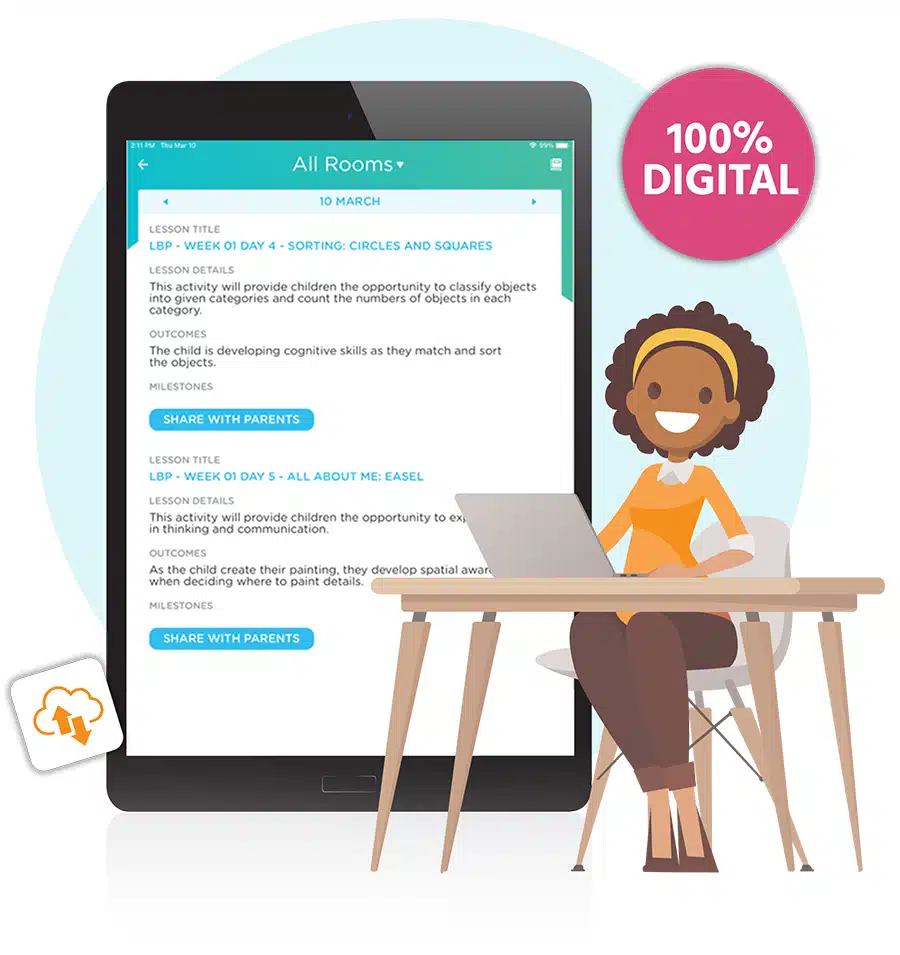
Cooperative play is characterized by children engaging in organized group play with specific roles and rules. They actively collaborate, communicate and share ideas with their peers. Collaborative play often involves games with rules, imaginary play scenarios and group activities.
The benefits of this type of play is fostering social skills, empathy, problem-solving abilities and teamwork. Cooperative play promotes positive socialization in a child’s world.
Cooperative play is a powerful tool for children’s development, providing them with invaluable opportunities to learn essential skills and build meaningful relationships.
As early childhood educators, it is essential to recognize and encourage the benefits of cooperative play to ensure that children have ample opportunities to engage in collaborative activities that will shape them into confident, empathetic and capable people.
As part of the Procare Solutions Series of Play blog series, let’s dig deeper into this style of play and look at five examples of cooperative play that you can use in your child care center!
Age Range for Cooperative Play
While every child is different and moves through the stages of play at a different pace, kids typically begin to engage in cooperative play between the ages of 4 and 5, according to Healthline.
The ability to play cooperatively depends on the child’s ability to learn and exchange ideas and assign and accept roles in their play.
Children under 4 are not yet ready to share their toys for the sake of a game or to understand the importance of rules and bounds within a game.
Examples of Cooperative Play
Any group game or activity with a narrative, theme or rules can fall under cooperative play. Here are three ideas to get us started:
- While children in associative play (another stage of play in younger children) might both play dress-up with no story or connection between the outfits, this could become a fashion show with themed outfits in cooperative play.
- A game of “cars” could turn into a race, with rules and a story arc.
- Instead of simply sharing the play kitchen, children may define play roles such as chef, waiter and customer to simulate a restaurant.
Let’s look at more cooperative play examples and their benefits.
Foster Social Skills
Cooperative play offers an ideal platform for children to develop crucial social skills. By engaging in activities that require collaboration, negotiation and communication, children learn to understand and respect the perspectives of others.
For example, a simple game of building blocks includes sharing ideas, taking turns and appreciating each other’s contributions. Through such experiences, children develop empathy, patience, and the ability to work harmoniously with others.

Encourage Teamwork
Cooperative play teaches children the value of teamwork and the importance of collective effort. Team sports, such as soccer or basketball, are excellent examples of cooperative play. These activities require coordination, cooperation and strategizing with teammates.
Children learn to rely on one another, communicate effectively and appreciate the unique strengths each team member brings.
By working towards a common objective, they develop essential skills that extend beyond the realm of play and into various aspects of their lives.
Enhance Problem-Solving Abilities
Cooperative play often presents children with challenges that require problem-solving skills. By collaborating with others, children learn to analyze situations, brainstorm solutions and make decisions collectively.
An example of this is puzzle solving. Whether it’s a jigsaw puzzle or a complex problem-solving game, children are encouraged to pool their ideas, share insights and think critically together.
Promote Creativity
Cooperative play stimulates creativity by providing children with opportunities to combine their imaginations and skills. Artistic endeavors, such as group art projects, encourage children to work together, share materials and brainstorm creative ideas.
By pooling their individual talents and perspectives, children create unique and inspiring works of art. Cooperative play not only expands their creativity but also cultivates a sense of pride and accomplishment in their collaborative creations.
Build Positive Relationships
Engaging in cooperative play helps children build positive relationships and develop a sense of belonging. By collaborating with other children, they learn to establish trust, resolve conflicts and appreciate diverse viewpoints. Cooperative play also fosters a sense of camaraderie and strengthens the bonds among participants.
Activities like building a fort, planning and performing a play as well as group storytelling create shared experiences that nurture lasting friendships and positive social connections.
How an Early Childhood Curriculum Can Help!

Cooperation is a learned behavior that can be improved and modified, which is especially developed during childhood. And developmentally appropriate play is an important part of how a child learns.
Procare Early Learning powered by Learning Beyond Paper is an all-digital early childhood curriculum specifically designed to meet the unique needs of educating children from infancy through pre-kindergarten.
The curriculum is embedded into Procare, making it easier and less time-consuming for busy teachers and administrators to provide high-quality education.
With Procare Early Learning powered by Learning Beyond Paper, child care centers can:
- Equip teachers with state-of-the-art online curriculum at their fingertips
- Dramatically reduce the amount of time spent on lesson planning each week
- Offer children a high-quality, developmentally appropriate curriculum
- Save money with this cost-efficient solution that’s integrated with Procare
This curriculum can be used in ALL child care center classrooms, with 52 weeks of lesson plans and more than 4,000 daily activities for infants, toddlers, preschoolers and pre-kindergarteners. Learning areas include STEAM, language and literacy, physical development, cognitive, music and movement as well as interactive reading. Plus, teachers get tips and tools they can use in real time!
Want to learn more? Visit www.procaresolutions.com/curriculum and check out these resources as well:
• Download the free eBook Procare Early Learning Powered by Learning Beyond Paper: What a Digital Curriculum Can Do For Your Child Care Center.”
• Learn how Procare Early Learning will save one West Virginia child care center up to $1,600 a month.
Procare is the only solution that can deliver the entire early childhood education ecosystem — lesson planning, lesson delivery within the classroom as well as assessment and parent engagement. Being able to do all of these with one platform simplifies classroom management and planning!
How much time and money could your child care center save using a digital curriculum designed for young learners? Enter your number of staff, number of students and type of program into our online calculator to learn your potential savings!



